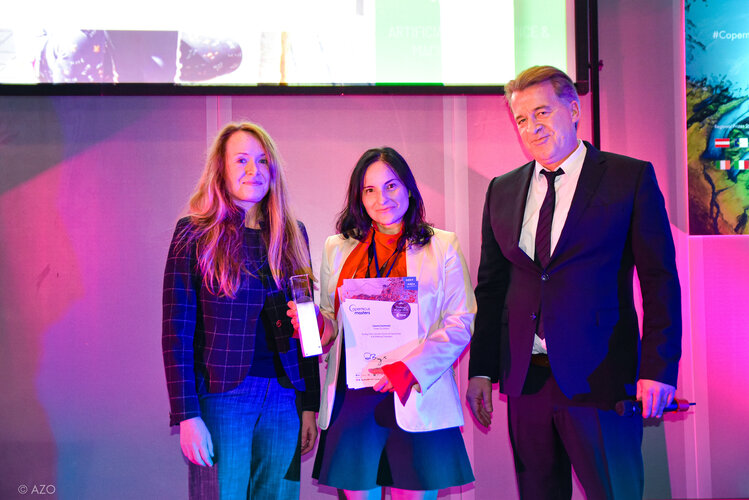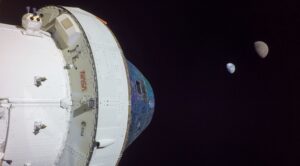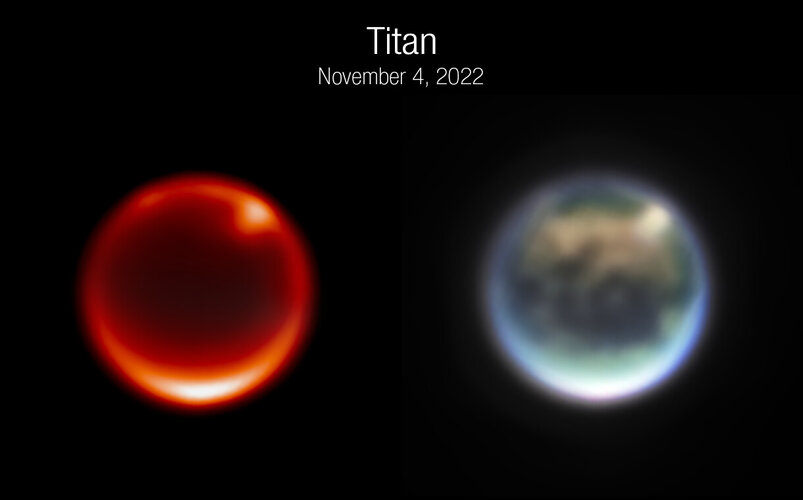Green City Makers wins top prize at Copernicus Masters
Friday, 02 December 2022 10:06
Green City Makers wins top prize at Copernicus Masters
Orion begins return leg of Artemis 1 mission
Friday, 02 December 2022 08:34
NASA’s Orion spacecraft started its trip back to Earth Dec. 1 with the first of two maneuvers that will put the spacecraft on course for a splashdown in the Pacific Ocean in a week and a half.
Earth from Space: the moraines of Malaspina
Friday, 02 December 2022 08:00
The remarkable moraine patterns of Malaspina Glacier – the largest piedmont glacier in the world – are featured in this false-colour image acquired by Copernicus Sentinel-2.
Webb tracks clouds on Saturn’s moon Titan
Friday, 02 December 2022 07:00 Image:
Image:
These are images of Saturn’s moon Titan, captured by the NASA/ESA/CSA James Webb Space Telescope’s NIRCam instrument on 4 November 2022. The image on the left uses a filter sensitive to Titan’s lower atmosphere. The bright spots are prominent clouds in the northern hemisphere. The image on the right is a color composite image. Click here for an annotated version of this image.
Titan is the only moon in the Solar System with a dense atmosphere, and it is also the only planetary body other than Earth that currently has rivers, lakes, and seas. Unlike Earth, however, the
Southern hemisphere's biggest radio telescope begins search for ET signatures
Friday, 02 December 2022 05:55 Breakthrough Listen has begun observations using a powerful new instrument deployed to the MeerKAT radio telescope in the remote Karoo region of South Africa. The new search for technosignatures - indicators of technology developed by extraterrestrial intelligence - expands the number of targets searched by a factor of 1,000.
The astronomers and engineers on the Breakthrough Listen team ha
Breakthrough Listen has begun observations using a powerful new instrument deployed to the MeerKAT radio telescope in the remote Karoo region of South Africa. The new search for technosignatures - indicators of technology developed by extraterrestrial intelligence - expands the number of targets searched by a factor of 1,000.
The astronomers and engineers on the Breakthrough Listen team ha NASA to cancel GeoCarb Mission, expands greenhouse gas portfolio
Friday, 02 December 2022 05:55 NASA announced Monday it intends to cancel development of its GeoCarb mission, and instead implement a plan for pursuing alternate options to measure and observe greenhouse gases.
Newer options to make key greenhouse gas measurements are emerging that were not previously available for the agency when considering GeoCarb. For example, NASA's newest instrument that launched in July to the In
NASA announced Monday it intends to cancel development of its GeoCarb mission, and instead implement a plan for pursuing alternate options to measure and observe greenhouse gases.
Newer options to make key greenhouse gas measurements are emerging that were not previously available for the agency when considering GeoCarb. For example, NASA's newest instrument that launched in July to the In NASA responds to Independent Review of Earth System Observatory
Friday, 02 December 2022 05:55 NASA shared a response Wednesday on an independent review board established to assess plans and goals for the next generation of Earth-observing satellites: NASA's Earth System Observatory, a cutting edge suite of spacecraft that will forward understanding of our changing planet.
The independent review board report examined the technical concepts developed so far for robustness as well as
NASA shared a response Wednesday on an independent review board established to assess plans and goals for the next generation of Earth-observing satellites: NASA's Earth System Observatory, a cutting edge suite of spacecraft that will forward understanding of our changing planet.
The independent review board report examined the technical concepts developed so far for robustness as well as The PI's Perspective: Extended Mission 2 Begins!
Friday, 02 December 2022 05:55 New Horizons remains healthy from its position deep in the Kuiper Belt, even as it speeds farther from the Earth and Sun by about 300 million miles per year! The spacecraft, which began its second extended mission on Oct. 1, also continues its record-length hibernation that began June 1 and ends March 1.
Hibernation, which takes place in spacecraft "spin mode," saves fuel and wear and tear
New Horizons remains healthy from its position deep in the Kuiper Belt, even as it speeds farther from the Earth and Sun by about 300 million miles per year! The spacecraft, which began its second extended mission on Oct. 1, also continues its record-length hibernation that began June 1 and ends March 1.
Hibernation, which takes place in spacecraft "spin mode," saves fuel and wear and tear HFES releases Policy Statement on Human Space Flight
Friday, 02 December 2022 05:55 The Human Factors and Ergonomics Society (HFES) has issued a new Policy Statement on Human Space Flight and Exploration Programs. As both government and commercial space operations continue to evolve and expand, this statement highlights the urgency and fundamental necessity to focus more attention on human factors engineering and human performance in the design of the technologies, training and
The Human Factors and Ergonomics Society (HFES) has issued a new Policy Statement on Human Space Flight and Exploration Programs. As both government and commercial space operations continue to evolve and expand, this statement highlights the urgency and fundamental necessity to focus more attention on human factors engineering and human performance in the design of the technologies, training and New minerals discovered in massive meteorite may reveal clues to asteroid formation
Friday, 02 December 2022 05:55 A team of researchers has discovered at least two new minerals that have never before been seen on Earth in a 15 tonne meteorite found in Somalia - the ninth largest meteorite ever found.
"Whenever you find a new mineral, it means that the actual geological conditions, the chemistry of the rock, was different than what's been found before," says Chris Herd, a professor in the Department of
A team of researchers has discovered at least two new minerals that have never before been seen on Earth in a 15 tonne meteorite found in Somalia - the ninth largest meteorite ever found.
"Whenever you find a new mineral, it means that the actual geological conditions, the chemistry of the rock, was different than what's been found before," says Chris Herd, a professor in the Department of Back to the Marker Band - Sols 3667-3668
Friday, 02 December 2022 05:55 Still stuffed and feeling thankful our weekend plans were successful! This morning's downlink showed we had more power to play with than was modeled last week, this time due to the SAM activities running conservatively on Sols 3662 and 3663 (Thanksgiving and the day after). From this "power gift" we were able to add a whole hour to our remote science time and use our DRT for a full sol of scienc
Still stuffed and feeling thankful our weekend plans were successful! This morning's downlink showed we had more power to play with than was modeled last week, this time due to the SAM activities running conservatively on Sols 3662 and 3663 (Thanksgiving and the day after). From this "power gift" we were able to add a whole hour to our remote science time and use our DRT for a full sol of scienc Tiangong space station open to world
Friday, 02 December 2022 05:55 Over the past 19 years, from China's first manned space mission Shenzhou V to the latest Shenzhou XV launch, the nation's space endeavors have progressed from a single-astronaut mission to the long-term stay of several astronauts in space. The number of astronauts one spaceship can carry has increased from one to three, and the length of time the astronauts stay in space has expanded from just 2
Over the past 19 years, from China's first manned space mission Shenzhou V to the latest Shenzhou XV launch, the nation's space endeavors have progressed from a single-astronaut mission to the long-term stay of several astronauts in space. The number of astronauts one spaceship can carry has increased from one to three, and the length of time the astronauts stay in space has expanded from just 2 Extraterrestrial signal search is underway using the southern hemisphere's biggest radio telescope
Friday, 02 December 2022 05:09 Breakthrough Listen has begun observations using a powerful new instrument deployed to the MeerKAT radio telescope in the remote Karoo region of South Africa. The new search for technosignatures - indicators of technology developed by extraterrestrial intelligence - expands the number of targets searched by a factor of 1,000.
The astronomers and engineers on the Breakthrough Listen team ha
Breakthrough Listen has begun observations using a powerful new instrument deployed to the MeerKAT radio telescope in the remote Karoo region of South Africa. The new search for technosignatures - indicators of technology developed by extraterrestrial intelligence - expands the number of targets searched by a factor of 1,000.
The astronomers and engineers on the Breakthrough Listen team ha NASA's Orion capsule performs burn to leave distant retrograde orbit
Friday, 02 December 2022 05:09 NASA's Orion space capsule, which is in day 16 of its Artemis I test flight, completed a burn Thursday to take it out of distant retrograde orbit.
The burn, which was livestreamed by NASA, began about 4:53 p.m. EST and lasted for 1 minute, 45 seconds, and was successful.
The procedure involved firing engines on the European service module which commits the spacecraft to leaving t
NASA's Orion space capsule, which is in day 16 of its Artemis I test flight, completed a burn Thursday to take it out of distant retrograde orbit.
The burn, which was livestreamed by NASA, began about 4:53 p.m. EST and lasted for 1 minute, 45 seconds, and was successful.
The procedure involved firing engines on the European service module which commits the spacecraft to leaving t Analyzing the rhythmically layered bedrock above the marker band: Sols 3669-3670
Friday, 02 December 2022 05:09 Curiosity drove ~25 meters back toward the Marker Band from our detour to the Gediz Vallis Ridge and has returned to the rhythmically layered bedrock we observed on Sols 3648-3649.
The first time Curiosity encountered these rocks we were unable to analyze them because one of the rover's wheels was perched on a rock. Now that we are parked safely, we will use a "Touch and Go" approach where
Curiosity drove ~25 meters back toward the Marker Band from our detour to the Gediz Vallis Ridge and has returned to the rhythmically layered bedrock we observed on Sols 3648-3649.
The first time Curiosity encountered these rocks we were unable to analyze them because one of the rover's wheels was perched on a rock. Now that we are parked safely, we will use a "Touch and Go" approach where 
